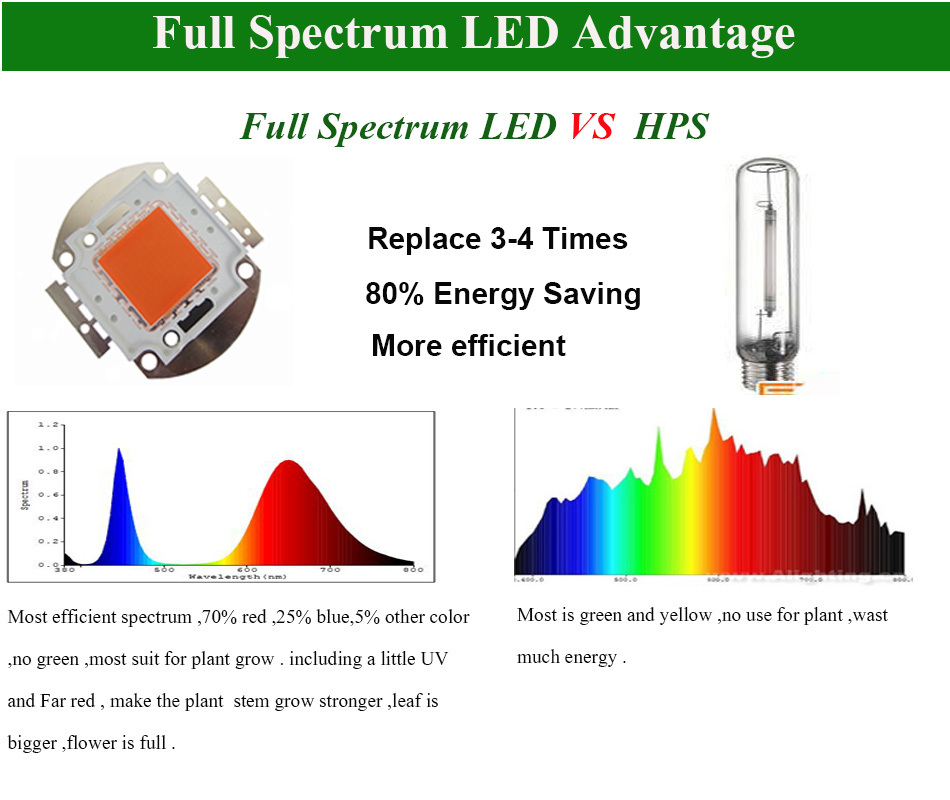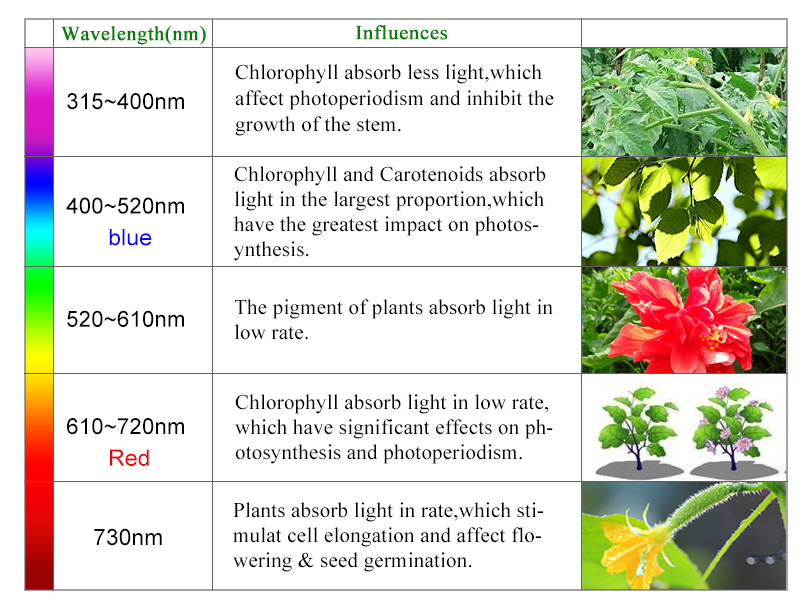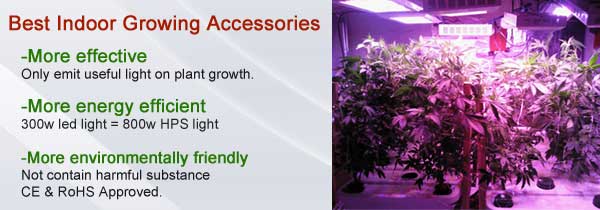LED Grow Lights Reviews
Horticulturists have been using electric lamps to grow plants for nearly 150 years, and the path of their development followed from incandescent lighting through to LED Grow Lights. HID grow Lights began with “Open arc lighting” and then, “high-pressure sodium” HPS lamps, which are still the most popular for supplemental lighting indoors and in greenhouses. These familiar orange high-pressure sodium lamps have high electrical efficiencies, and long operating life and a wide spectrum of light which is suitable for many plant species.
Unfortunately, the peak emission from HPS grow Lights is in the yellow light or 589 nm region. High amounts of this yellow light can cause stem elongation and lower the quality of crops. Solid-state lighting, using LED grow Lights represents a fundamentally different technology from the gaseous discharge type lamps currently used in horticulture and has more advantages than the traditional forms of HID grow lighting. These Opto electronic SSL solid-state lighting devices feature high radiant efficiency, long lifetime cools admitting temperature, relatively narrow spectrum emission, short switching time, and contain no mercury or other hazardous contaminants.
High brightness LED grow Lights are already available the entire spectrum relevant for our horticulture purposes. Spectra mixes can be customized for specific crops, optimizing maximum production without wasting energy outputting nonproductive wavelengths.
First Gen LEDs Had limited Success
Early LED grow lights came in a mix of red and blue DIP LEDs with little concern over color spectra. At first these LED grow Lights were well under 1 W each, then the next generation utilized 1 W LEDs that were beginning to become more spectrum specific. Many claims were made; professional horticulturists reported only limited success with these early models.
Now in 2013, LED grow lights have become a viable option for indoor hydroponic gardening. A 200 to 300 Watt LED array can now effectively replace a 600 W*(in luminance output of specific spectrums only)
LED grow Light costs Still expensive
“660-670-680nm LED emitters are much more expensive than 630nm. The same for Blue – 460nm are less expensive than 410-400nm. Highest quality (made in USA) LED grow Lights (670nm, 450+430nm and 500mW IR) are very expensive – around 22$ each”
By concentrating light output in key bandwidths energy use is minimized, while growth and flowering maximized.
Researchers have been able to narrow down exactly which wavelengths have the most impact on plant growth, let’s look at tomatoes as an example, in an indoor hydroponics setting
Healthy plants need: 440nm, 469nm, 642nm, 667nm and 740nm in various intensities.
There are a minimum of five-seven spectra “Photosynthetic Reactive Radiation”, needed to mimic growth incurred in natural environment, in fact because of environmental control, growth rates and yields can often exceed similar crops in outdoor settings.
During the noon day sun when light is at its most intense the color temperature is a very blue 5000 “Kelvin” to 7000 K. during this time, green growing plants have been known to grow in excesses of one to 4 inches per day. Simulating this intense noon day sun encourages vegetative growth.
Flowering and fruiting plants often have a type of trigger, such as shorter days signal a plant to flower before the oncoming of winter. Long August summer nights produce much redder spectrum, flowering plants tend to respond more to red spectrum because of these biological triggers.
Can LED grow lights fully replace metal halide for horticultural use?
Today’s modern high efficiency LED arrays can be configured for any growing environment, it can be designed to be mounted 3 m(10 feet) plus above crops to provide maximum coverage, or can be designed with wide angle lenses so LED Arrays may be placed directly over crop’s (within 40 centimeters or 20 inches)
Unfortunately, the peak emission from HPS grow Lights is in the yellow light or 589 nm region. High amounts of this yellow light can cause stem elongation and lower the quality of crops. Solid-state lighting, using LED grow Lights represents a fundamentally different technology from the gaseous discharge type lamps currently used in horticulture and has more advantages than the traditional forms of HID grow lighting. These Opto electronic SSL solid-state lighting devices feature high radiant efficiency, long lifetime cools admitting temperature, relatively narrow spectrum emission, short switching time, and contain no mercury or other hazardous contaminants.

High brightness LED grow Lights are already available the entire spectrum relevant for our horticulture purposes. Spectra mixes can be customized for specific crops, optimizing maximum production without wasting energy outputting nonproductive wavelengths.
First Gen LEDs Had limited Success
Early LED grow lights came in a mix of red and blue DIP LEDs with little concern over color spectra. At first these LED grow Lights were well under 1 W each, then the next generation utilized 1 W LEDs that were beginning to become more spectrum specific. Many claims were made; professional horticulturists reported only limited success with these early models.
Now in 2013, LED grow lights have become a viable option for indoor hydroponic gardening. A 200 to 300 Watt LED array can now effectively replace a 600 W*(in luminance output of specific spectrums only)
LED grow Light costs Still expensive
“660-670-680nm LED emitters are much more expensive than 630nm. The same for Blue – 460nm are less expensive than 410-400nm. Highest quality (made in USA) LED grow Lights (670nm, 450+430nm and 500mW IR) are very expensive – around 22$ each”
By concentrating light output in key bandwidths energy use is minimized, while growth and flowering maximized.

Researchers have been able to narrow down exactly which wavelengths have the most impact on plant growth, let’s look at tomatoes as an example, in an indoor hydroponics setting
Healthy plants need: 440nm, 469nm, 642nm, 667nm and 740nm in various intensities.
There are a minimum of five-seven spectra “Photosynthetic Reactive Radiation”, needed to mimic growth incurred in natural environment, in fact because of environmental control, growth rates and yields can often exceed similar crops in outdoor settings.
During the noon day sun when light is at its most intense the color temperature is a very blue 5000 “Kelvin” to 7000 K. during this time, green growing plants have been known to grow in excesses of one to 4 inches per day. Simulating this intense noon day sun encourages vegetative growth.
Flowering and fruiting plants often have a type of trigger, such as shorter days signal a plant to flower before the oncoming of winter. Long August summer nights produce much redder spectrum, flowering plants tend to respond more to red spectrum because of these biological triggers.
Can LED grow lights fully replace metal halide for horticultural use?
Today’s modern high efficiency LED arrays can be configured for any growing environment, it can be designed to be mounted 3 m(10 feet) plus above crops to provide maximum coverage, or can be designed with wide angle lenses so LED Arrays may be placed directly over crop’s (within 40 centimeters or 20 inches)
Metal halide and high pressure sodium grow lights have a dead spot at the bottom of the bulb directly underneath. The light produced is in a 360° beam that must be focused and concentrated on the growing area, using metal halide and high-pressure sodium in, reflectors, hoods and other fixtures, further reduce usable light output. Stadium type setups for these type of light bulbs are often needed to keep plants equal distance from light source.

Related Posts
Copyright © 2023 Zhejiang Seming Electronic Co., Ltd.






